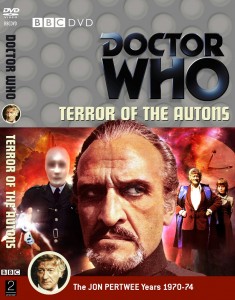 After 3 weeks of rehab for a back injury, I’m back! Welcome to the twenty-ninth instalment of Who Review. This week,we see the introduction of one of the Doctor’s greatest villains in Terror of the Autons.
After 3 weeks of rehab for a back injury, I’m back! Welcome to the twenty-ninth instalment of Who Review. This week,we see the introduction of one of the Doctor’s greatest villains in Terror of the Autons.
EPISODES
Terror of the Autons (4 Episodes)
BROADCAST DATES
02 January – 23 January 1971
THE DOCTOR
Jon Pertwee
THE COMPANIONS
Jo Grant
THE EPISODES
Arriving on Earth in his TARDIS, the evil Timelord The Master uses his hypnotic powers to seize control of a travelling carnival. Using the carnival as his base of operations, he steals the last remaining Nestene energy unit (as seen previously in Spearhead From Space). Breaking into a deep space radio telescope facility, he overwhelms the staff working there, connects the energy unit to one of the towers and broadcasts a message into deep space.
At UNIT HQ, reports of the theft and break-in reach the Brigadier, who asks the Doctor to aid him in his investigation. The Brigadier also introduces the Doctor to his new assistant, Jo Grant. At first, the Doctor is resistant to Jo’s presence, asking for the return of Liz Shaw. The Brigadier informs him that Liz has returned to Cambridge. Slowly, the Doctor warms to his new assistant.
Travelling to the radio facility to investigate the break-in, the Doctor receives a visit from another Time Lord who warns him that his old enemy, the Master, has arrived on Earth. Searching the radio tower, he finds the dead, miniaturised body of one of the workers and learns that a scientist, Professor Phillips, is missing.
Meanwhile, the Master uses his hypnosis to take control of a local plastic factory. Using the factory’s facilities, he begins mass production of Autons. Realising the Master’s link to the Autons, the Doctor has UNIT investigate all of the local plastic factories in the hope of finding the villain.
Jo manages to track the Master down, but he uses hypnosis to wipe her memory of the encounter and reprogram her to kill the Doctor. He gives her a booby trapped container and sends her back to UNIT HQ. Fortunately, the Doctor realises she is under hypnotic control and disposes of the container before it can hurt anyone.
Back at the plastic factory, The Master becomes embroiled in a power struggle at the plastic factory with the factory’s owner, who manages to resist the villain’s hypnotic stare. Using a hideous animated plastic doll, the Master has the owner murdered.
Elsewhere, UNIT soldiers find the missing Professor Phillips at the travelling carnival. The Doctor travels to the carnival to investigate but is captured before he can open the Master’s TARDIS. He is freed by Jo, who has followed him to the carnival against his express wishes. The Doctor then removes the dematerialisation unit from the Master’s TARDIS, rendering the time machine unusable.
Before they can flee, they are attacked by the carny folk. They are seemingly rescued by two policemen and escorted away, but the police are actually Autons who try to kill them. They manage to escape the villains and are rescued by the Brigadier and his men. A firefight breaks out but they manage to escape.
At the plastic factory, the Master creates a deadly plastic daffodil rigged to asphyxiate anyone holding it. He has the factory manager charter a bus to transport Autons dressed in garish outfits to distribute the deadly flowers to the public. As the flowers activate, reports begin filing into UNIT HQ of a rash of deaths by suffocation and heart failure.
Finally locating the now-abandoned plastic factory, the Doctor and the Brigadier discover one of the daffodils and learn that the factory manager has chartered the bus. Returning to HQ, they determine how the device works and link it to the spate of deaths being reported. They discover that the daffodils are to be activated by a signal from the Radio Telescope and that the unexplained deaths were shortwave radio users who activated theirs prematurely.
UNIT troops manage to locate the missing bus in a nearby field. The Brigadier orders an air strike to take out the bus and the Autons.
Discovering that the dematerialisation unit is missing from his TARDIS, the Master arrives at UNIT HQ to confront the Doctor. Before he can kill them, he learns that UNIThas discovered the bus and are planning an air strike. He takes the Doctor and Jo hostage and takes them to the bus, hoping that the air strike will kill them. He then heads for the radio tower to await the arrival of the Nestene Consciousness.
Fortunately, the Brigadier is able to call off the strike at the last moment. Using her impressive escapology skills, Jo manages to free herself and the Doctor and they escape. UNIT troops descend on the bus, engaging the Autons while the Doctor and the Brigadier head for the radio tower.
At the tower, The Master is on the verge of success as the Nestenes begins to materialise. The Doctor confronts him and manages to convince him that the Nestenes will not distinguish between friend and foe when they arrive; they’ll kill the Master alongside all of humanity. Seeing the error of his plan, the Master agrees to help the Doctor. Together, they reverse the radio signal, expelling the Nestenes and causing the Autons to collapse.
The Master escapes the tower and flees to the bus, where he is cornered. He emerges, seemingly surrendering, but then pulls a gun and is shot down by UNIT troops. A skeptical Doctor examines the body and learns it is actually Farrell disguised as the Master. The real Master flees in the bus and escapes.
With the Master now trapped on Earth, the Doctor admits that he is looking forward to their next encounter.
MY THOUGHTS
Terror of the Autons is a solid and entertaining story that is elevated to greatness by the presence of one man: Roger Delgado as The Master. His dominating screen presence is felt from the opening scene of Terror and continues throughout the storyline.
In the Master, we see the perfect combination of flawless character writing and excellent casting. It’s a credit to producer Barry Letts, script editor Terrence Dicks and writer Robert Holmes that they have crafted an almost faultless introduction to the villain, one that establishes all the key elements of the character: his intelligence, his motivations, his abilities and his incredible guile and cunning.
Dicks has stated that the genesis of the Master came from a conversation between him and Letts about the nature of the Doctor/Brigadier relationship, one which they compared to Sherlock Holmes/John Watson. Naturally, this led to the idea of introducing a Moriarty-like villain for the Doctor to match wits with. The parallels between Moriarty and the Master are easily apparently; they are both master manipulators seeking to control those around them, they both crave power and they are in all ways the intellectual equal, if not superior, to their nemesis.
What’s truly impressive however is that the Master always seems to be two or three steps ahead of the Doctor. It has been incredibly rare up to this point to see the Doctor outwitted, but the Master manages to achieve that goal time and time again. Even at the end of the story, the Doctor doesn’t really defeat him; he simply shows him the error in his plans and convinces him to help disperse the Nestenes.
Unfortunately, this ending is probably the weakest aspect of Terror. It feels a little rushed, and the Master’s change of heart is very sudden. It could be argued that the Doctor’s argument is so compelling that the Master doesn’t even need to reflect on it, but given how much time and effort he’s put into his plans, I’d have preferred a little more conflict before the Master’s conviction changes.
Despite this, Terror of the Autons is still an impressive opening to Pertwee’s second season as The Doctor.
THE DOCTOR
One of the signs of a truly great villain is the way in which they add an extra dimension to the hero. As an arch nemesis, The Master offers The Doctor a truly nefarious villain to match his considerable wits against. Finally he has somebody on Earth who is his intellectual equal, somebody who can provide him with a genuine challenge, and it’s a challenge that he relishes.
THE COMPANIONS
Once again, a companion is given a sudden and dismissive departure from Doctor Who, with the actress not even making a final appearance to receive their send off. Liz Shaw is gone, her departure explained briefly and nonchalantly by the Brigadier as a means of introducing the new companion, Jo Grant.
I’m not sold on Jo just yet. She shows signs in Terror if a slightly adventurous and rebellious streak, a willingness to challenge the Doctor and not simply follow his lead. She openly defies the Doctor’s explicit instructions on a couple of occasions in Terror, adding a certain dynamic to their relationship that wasn’t present with Liz and many of the past companions.
For now, I’m willing to withhold judgment until I see where they’re going with Jo’s character. There’s some positive signs there but not enough just yet.
We also see the addition of Captain Mike Yates to the UNIT team and a slightly expanded role for Sargent Benton. Both are greatly welcomed, as outside of the Brigadier, UNIT ran the risk of being merely a faceless group of soldiers/cannon fodder.
THE VILLAINS
I’ve already raved about the introduction of the Master. However, his presence in Terror is in many ways detrimental to the Autons. I wasn’t really a big fan of these villains in their first appearance (Spearhead From Space) as I felt that they lacked a strong motivation. The addition of the Master as leader of the killer manikins helps overcome these shortcomings and gives focus to their efforts, but it also highlights their shortcomings.
The emphasis in Terror is on the Master’s efforts at all times, with the Autons serving as little more than flunkies to his plans. Unfortunately, this merely illustrates how ineffective the Autons are as villains in their own right; they require an additional presence such as the Master to make them work.
FINAL THOUGHTS
Without the Master, Terror of the Autons would be a solid and entertaining story. His presence elevates to something truly memorable.
4 Lukes
NEXT
The Doctor and the Master match wits once again in The Mind of Evil.









